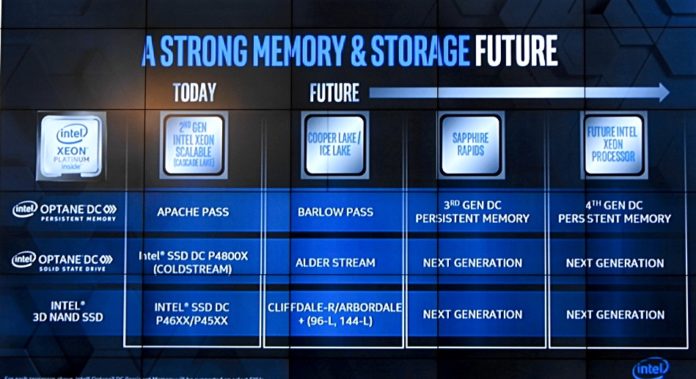Intel’s second generation Optane storage-class memory is code-named Barlow Pass, and the company is developing 144-layer QLC (4bits/cell) NAND technology.
The chip giant is also opening a second Optane development line at its Rio Rancho, New Mexico facility, which will run gen 2 wafers through the first line.
At an Intel Memory and Storage Day briefing in Seoul today , Kristie Mann, head of product management for the Data Center Group, showed this slide;:

Mann’s slide shows there is a roadmap for generations 3 and 4 of Optane, with Sapphire Pass Xeons and then an un-named future Xeon after that.
The company will release Barlow Pass DIMMs in 2020, along with Cooper Lake (14nm) and Ice Lake (10nm) versions of the Xeon CPUs. Alder Stream gen 2 Optane SSDs are also coming.
A single-port gen 2 Optane enterprise drive is expected in 2020. A new controller will speeds things up even more.
Blocks & Files thinks Optane gen 2 will have 4 layers instead of the 2 in gen 1. We think DIMM gen 1 capacities of 128GB, 256GB and 512GB will double with gen 2 to 256GB, 512GB and 1TB.
Intel fellow Frank Hady confirmed this, and said gen 2 Optane has 4 layers, doubling the size of the die. In theory that means Intel could double the capacity of Optane drives and DIMMs.
More Barlow Pass details – capacity, endurance and performance – will come in a later article. Intel is in drip feed mode.
However the company revealed that Microsoft is updating its client OS to support Optane gen 2 features.
144-layer NAND
Intel will ship 96-layer QLC SSDs to customers next quarter. It will then move to 144-layer 3D NAND and will ship 144-layer SSDs in 2020. (This is likely to be a pair of 72-layer string stacks although we await confirmation)
VAST Data uses Optane and QLC flash. Expect VAST Data to use gen 2 Optane and the 96-layer and 144-layer QLC NAND drives. VAST’s Jeff Denworth, VP Product Management, said: “VAST is primed to go from today’s 64 layer QLC to whatever 3D NAND QLC offering Intel has in the future.”
Rob Crooke, GM for Intel’s Non-volatile Memory Solutions Group, said Intel is developing Optane persistent memory for PCs and notebooks that could remove the need for storage. Applications could be changed almost instantaneously by switching a pointer to Optane memory instead of loading the new app from storage.








